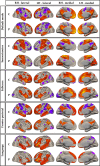Resting-state functional brain networks in adults with a new diagnosis of focal epilepsy
- PMID: 30488645
- PMCID: PMC6346674
- DOI: 10.1002/brb3.1168
Resting-state functional brain networks in adults with a new diagnosis of focal epilepsy
Abstract
Objectives: Newly diagnosed focal epilepsy (NDfE) is rarely studied, particularly using advanced neuroimaging techniques. Many patients with NDfE experience cognitive impairments, particularly with respect to memory, sustained attention, mental flexibility, and executive functioning. Cognitive impairments have been related to alterations in resting-state functional brain networks in patients with neurological disorders. In the present study, we investigated whether patients with NDfE had altered connectivity in large-scale functional networks using resting-state functional MRI.
Methods: We recruited 27 adults with NDfE and 36 age- and sex-matched healthy controls. Resting-state functional MRI was analyzed using the Functional Connectivity Toolbox (CONN). We investigate reproducibly determined large-scale functional networks, including the default mode, salience, fronto-parietal attention, sensorimotor, and language networks using a seed-based approach. Network comparisons between patients and controls were thresholded using a FDR cluster-level correction approach.
Results: We found no significant differences in functional connectivity between seeds within the default mode, salience, sensorimotor, and language networks and other regions of the brain between patients and controls. However, patients with NDfE had significantly reduced connectivity between intraparietal seeds within the fronto-parietal attention network and predominantly frontal and temporal cortical regions relative to controls; this finding was demonstrated including and excluding the patients with brain lesions. No common alteration in brain structure was observed in patients using voxel-based morphometry. Findings were not influenced by treatment outcome at 1 year.
Conclusions: Patients with focal epilepsy have brain functional connectivity alterations at diagnosis. Functional brain abnormalities are not necessarily a consequence of the chronicity of epilepsy and are present when seizures first emerge.
Keywords: brain connectivity; cognitive dysfunction; new-onset seizures; treatment outcome.
© 2018 The Authors. Brain and Behavior published by Wiley Periodicals, Inc.
Figures




References
Publication types
MeSH terms
Grants and funding
LinkOut - more resources
Full Text Sources
Medical

